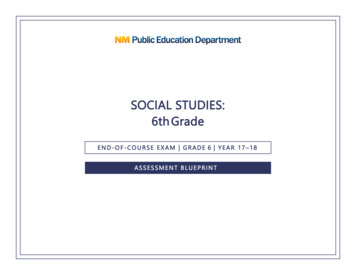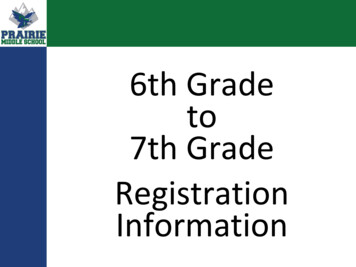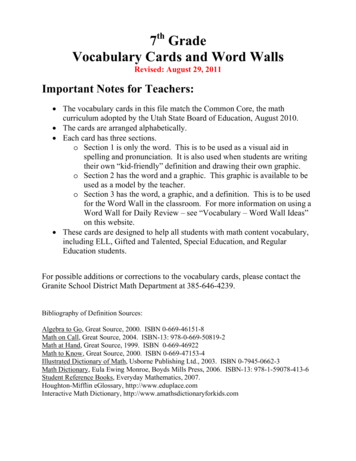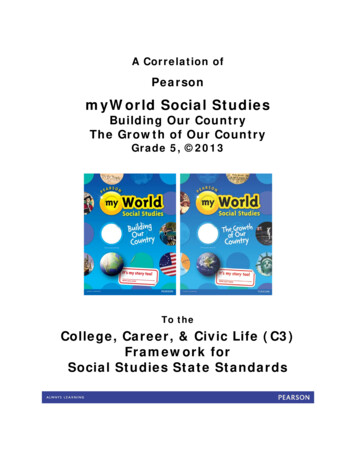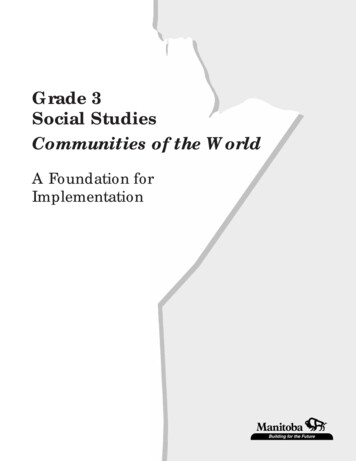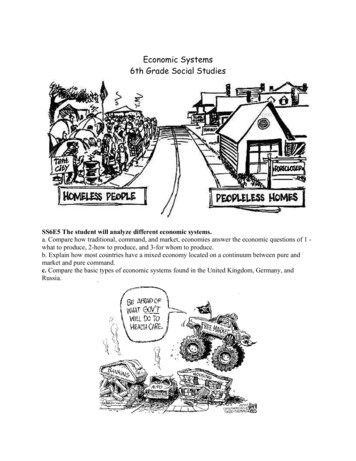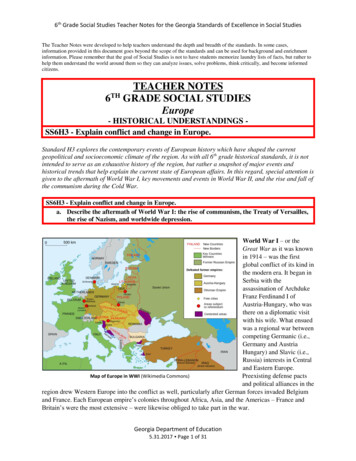
Transcription
6th Grade Social Studies Teacher Notes for the Georgia Standards of Excellence in Social StudiesThe Teacher Notes were developed to help teachers understand the depth and breadth of the standards. In some cases,information provided in this document goes beyond the scope of the standards and can be used for background and enrichmentinformation. Please remember that the goal of Social Studies is not to have students memorize laundry lists of facts, but rather tohelp them understand the world around them so they can analyze issues, solve problems, think critically, and become informedcitizens.TEACHER NOTES6TH GRADE SOCIAL STUDIESEurope- HISTORICAL UNDERSTANDINGS SS6H3 - Explain conflict and change in Europe.Standard H3 explores the contemporary events of European history which have shaped the currentgeopolitical and socioeconomic climate of the region. As with all 6th grade historical standards, it is notintended to serve as an exhaustive history of the region, but rather a snapshot of major events andhistorical trends that help explain the current state of European affairs. In this regard, special attention isgiven to the aftermath of World War I, key movements and events in World War II, and the rise and fall ofthe communism during the Cold War.SS6H3 - Explain conflict and change in Europe.a. Describe the aftermath of World War I: the rise of communism, the Treaty of Versailles,the rise of Nazism, and worldwide depression.World War I – or theGreat War as it was knownin 1914 – was the firstglobal conflict of its kind inthe modern era. It began inSerbia with theassassination of ArchdukeFranz Ferdinand I ofAustria-Hungary, who wasthere on a diplomatic visitwith his wife. What ensuedwas a regional war betweencompeting Germanic (i.e.,Germany and AustriaHungary) and Slavic (i.e.,Russia) interests in Centraland Eastern Europe.Map of Europe in WWI (Wikimedia Commons)Preexisting defense pactsand political alliances in theregion drew Western Europe into the conflict as well, particularly after German forces invaded Belgiumand France. Each European empire’s colonies throughout Africa, Asia, and the Americas – France andBritain’s were the most extensive – were likewise obliged to take part in the war.Georgia Department of Education5.31.2017 Page 1 of 31
6th Grade Social Studies Teacher Notes for the Georgia Standards of Excellence in Social StudiesRussian participation in World War I, and the war’s unpopularityamong the Russian people, contributed to the rise of communism inthat country. A popular revolution against the rule of Czar Nicholas IIRomanov, beginning in 1914, led to the Russian monarchy’s overthrowand Russia’s withdraw from World War I in 1917. A civil war ensued,resulting in the communist takeover of Russia by Vladimir Lenin andthe nation’s expansion and rebirth as the Soviet Union in 1922.The United States remained neutral throughout most of World War I,but did eventually enter the conflict on behalf of the Allies (Britain,France, Russia, et al) in 1917. The U.S. was instrumental in the defeatof the Central Powers (Germany, Austria-Hungary, the OttomanEmpire, et al.)An armistice was signed in 1918, and World War I officially came toan end in 1919 with the Treaty of Versailles (vair-sy’). The Treaty ofVersailles would later lead to renewed conflict with Germany, however,as the terms of Germany’s surrender (e.g., loss of lucrative territory, military occupation, etc.) wereconsidered overly punitive and financially untenable by its people.Vladimir Lenin(Wikimedia Commons)The rise of Nazism in 1919 came in direct response to the German public’s outrage over the Treaty ofVersailles. The Nazi movement gained traction in the early 1930s – as did likened fascist movementselsewhere in Central and Eastern Europe – after the 1929 U.S. stock market crash triggered a worldwidedepression. Strong leadership, the Nazis argued, and social policies that put the German people andGerman interests above all else were required to pull their nation out of economic calamity.1 Allies – the victorious alliance of nations in World War Iarmistice – a formal ceasefireCentral Powers – the defeated alliance of nations in World War Icommunism – a sociopolitical model wherein all property is publically owned and workers are paidaccording to their abilities and needsdepression – in economics, a long-term, sustained downturn in economic activityfascist – a political movement supporting strong, authoritarian government dictatorshipLenin, Vladimir – leader of the communist revolution in Russia during World War INazism – a political movement in Germany, from the end of World War I through the end of WorldWar II, which espoused totalitarian government, staunch nationalism, and racial supremacySoviet Union – a federation of communist countries in Eastern Europe, led by Russia, from the timeof the Russian Revolution until its collapse in 1991 at the end of the Cold WarTreaty of Versailles – the 1919 treaty which formally brought World War I to an endWorld War I – also known as the “Great War” or the “War to End all Wars,” a global conflictoccurring between 1914 and 1918, primarily in Europe1This pro-German nationalism was epitomized by the original first verse of what later became Germany’s nationalanthem: Deutschland, Deutschland über alles, / über alles in der Welt. (“Germany, Germany above all / Above all elsein the world.”)Georgia Department of Education5.31.2017 Page 2 of 31
6th Grade Social Studies Teacher Notes for the Georgia Standards of Excellence in Social StudiesResources:Causes of World War IThorough article, complete with multimedia and primary/secondary sources, on the Great Warhttp://www.gohistorygo.com/causes-of-wwiWar and Revolution in Russia, 1914-1921 (BBC)A deeper look into the events surrounding the Russian Revolution and subsequent civil stern front 01.shtmlThe Treaty of VersaillesThorough article, complete with multimedia and primary/secondary sources, on the Great The Roaring TwentiesArticle and video summarizing the changes in American society in the years following World War Ihttp://www.history.com/topics/roaring-twentiesThe Rise of the Nazi Party, 1918-1933 (A Teacher’s Guide to the Holocaust)Timeline of major events in German history which gave rise to the Nazi political zirise.htmThe Great Depression in Global PerspectiveAn explanation of how financial events in the U.S. triggered worldwide economic calamityhttp://www.digitalhistory.uh.edu/disp textbook.cfm?smtID 2&psid 3433SS6H3 - Explain conflict and change in Europe.b. Explain the rise of Nazism including preexisting prejudices, the use of propaganda, andevents which resulted in the Holocaust.Disillusionment with the outcome of World War I, lack of confidence inGermany’s post-war leadership, and economic calamity resulting from aworldwide depression all contributed to the rise of Nazism. Adolf Hitler’selection to the German chancellery in 1933 brought with it a policy ofstate-sponsored anti-Semitism. Nazi propaganda scapegoated the Jewishpeoples of Central Europe as complicit in the punitive terms of the Treatyof Versailles, and implicated them in the financial collapse which broughtabout Germany’s economic struggles in the post-war years. As such, partymembers and Nazi sympathizers alike were encouraged to boycott Jewishbusinesses, segregate Jewish people within German society, pass lawswhich forbade certain civil rights and privileges to Jews, and publicallyburn Jewish literature and religious sites. This anti-Jewish hysteria andpersecution culminated in the roundup, internment, and extermination ofEuropean Jewry, known as the Holocaust.22Adolf Hitler(Wikimedia Commons)An alternate Hebrew name for the Holocaust, the Shoah, is preferred by many Jewish survivors and scholars.Shoah means great destruction, total ruin, or calamity.Georgia Department of Education5.31.2017 Page 3 of 31
6th Grade Social Studies Teacher Notes for the Georgia Standards of Excellence in Social StudiesThe major events of the Holocaust took place against abackdrop of World War II. In fact, the event whichtriggered Western Europe’s declaration of war againstNazi Germany was Hitler’s invasion of Poland: aBritish and French ally with the continent’s largestJewish population at the time. Many of the ghettos andconcentration camps established by the Nazis werenot in Germany itself but in its surrounding conqueredterritories, like Poland.Hitler and the Axis (Germany, Italy, Japan, et al) wereultimately defeated at the end of World War II;however,the Allied victory did not come before nearlyInfamous sign at the gates of the Auschwitz11millionpeople3 lost their lives in the Holocaust,concentration/death camp in Oświęcim, Poland. The signreads Arbeit macht frei, which means "Work will set you some 6 million of whom were Jews.4free." (Wikimedia Commons) Allies – the victorious alliance of nations in World War IIanti-Semitism – racial bias or prejudice against JewsAxis – the defeated alliance of nations in World War IIconcentration camp – general term for a Nazi-controlled detention center where Jews, et al weredetained, used as forced labor, and exterminatedghetto – a cordoned off area of city where Jews were isolated from the rest of the German populationHitler, Adolf – chancellor of Germany and leader of the Nazi regime during World War IIHolocaust - the Nazi internment, forced labor, and extermination of nearly 11 million people duringWorld War II, an estimated 6 million of whom were Jewspropaganda – information, usually misleading or biased, designed to promote a particular politicalideologyWorld War II – a global conflict occurring between 1939 and 1945Resources:Hitler’s GermanyThorough article, complete with multimedia and primary/secondary sources, on Nazi ��The Nazi Racial State” by Professor Peter Longerich (BBC)Article detailing the extent of Hitler’s race-based politicking in World War racial state 01.shtmlChanging Life in Germany (GCSE Bitesize / BBC)Summary information with infographics about life under Nazi ory/tch wjec/germany19291947/2politicalpolicy1.shtml3Other groups targeted during the Holocaust included communists, the Roma/Sinti, Poles and other Slavic peoples,Jehovah’s Witnesses, and the mentally and physically disabled.4“Documenting Numbers of Victims of the Holocaust and Nazi Persecution.” Holocaust Encyclopedia. UnitedStates Holocaust Memorial Museum. 2 Jul. 2016. Web. 15 Nov. 2016.Georgia Department of Education5.31.2017 Page 4 of 31
6th Grade Social Studies Teacher Notes for the Georgia Standards of Excellence in Social StudiesSS6H3 - Explain conflict and change in Europe.c. Explain how German reunification contributed to the collapse of the Soviet Union andled to the end of the Cold War.Without a common enemy to unite them, relations between thecapitalist, democratic West and the communist, authoritarian Eastbegan to break down after World War II. Both the U.S. and theU.S.S.R., having risen to geopolitical “superpower” status as aresult of the war, sought to set the course for world affairs in theyears that followed. This period is known as the Cold War.The Cold War was, in essence, a battle of wills and sociopoliticalideologies. Unlike the openly-declared hostilities of the first twoWorld Wars, the Cold War was characterized by politicalpropaganda, threats, and smaller-scale skirmishes, but it stoppedshort of full-scale military engagement. Nowhere in Europe wereCold War tensions quite so poignant as Germany.East GermanyWest GermanyImmediately following Germany’s defeat in World War II, stepswere taken to ensure that Germany would never again pose amilitary threat to the peace and stability of Europe. As such, theMap of the divided West and East Germanynation was divided into four separate occupation zones. The threeduring the Cold War. The yellow area markswesternmost zones were occupied by American, British, andthe location of the divided capital, Berlin.French forces; the easternmost zone was occupied by Soviet(Wikimedia Commons)troops. This same division was also carried out in Germany’scapital, Berlin. Overtime, the three western zones were merged into one, known colloquially as WestGermany (officially the Federal Republic of Germany or FRG), while the Soviet portion of the countrybecame East Germany (officially the German Democratic Republic or GDR.) The four occupationzones in Berlin were also consolidated, becoming West Berlin and East Berlin.Government and society in the FRG (and WestBerlin) were recast in the image of the West:capitalist and democratic. The GDR (and EastBerlin), meanwhile, mirrored the Soviet Union’sother occupied territories: communist andauthoritarian. East Germans were only permittedto travel within the Communist Bloc; however,those who could make it to West Berlin could flyout of East Germany to freedom. Knowing this,and in an effort to stop the hemorrhage of highlyskilled East Germans emigrating to the West, theEast German government erected a massive,fortified, 91-mile long wall around West Berlin.This wall came to symbolize the “iron curtain”which divided the East and West throughout theCold War.Map of West and East Berlin (Wikimedia Commons)Georgia Department of Education5.31.2017 Page 5 of 31
6th Grade Social Studies Teacher Notes for the Georgia Standards of Excellence in Social StudiesCommunist influence over the economic decisions and internal politics of Eastern Europe persistedthroughout the Cold War. It was not until the 1980s that Soviet power began to wane, at which pointmany Eastern bloc nations began abandoning communism.Communism’s death knell came in 1989 with the destruction of the Berlin Wall. The wall stood fornearly three decades, not only as a literal divide between West and East Berlin but also as a symbolicdivide between the divergent ideologies of the East and West. With the fall of the Berlin Wall, democraticideals spread into communist territories and weakened communist political control.With the Soviet Union no longer capable – politically or financially – of maintaining a presence in EastGermany, the FRG and GDR were reunified into a single German state in 1990. One year later, theSoviet Union itself was dissolved and the Cold War came to an end. Cold War – a state of political hostility between countries without an outright declaration of warBerlin – the capital of GermanyFederal Republic of Germany (FRG) – the official name of West Germany during the Cold WarGerman Democratic Republic (GDR) – the official name of East Germany during the Cold WarCommunist Bloc – communist states of Central and Eastern Europe during the Cold Wariron curtain – a term coined by British Prime Minister Winston Churchill describing thesociopolitical and ideological divide between the West and East (especially the Soviet Union)Berlin Wall – a 91-mile wall surrounding West Berlin from 1961 through 1989German reunification – the reintegration of West and East Germany into a single nation in 1990RESOURCESCold War HistoryArticle and multimedia about the major events of the Cold -historyCold War GermanyThorough article, complete with multimedia and primary/secondary sources, on Germany during theCold War, the Berlin Wall, and German erlin“The Berlin Wall Falls and USSR Dissolves” (U.S. Department of State, Office of the Historian)Synopsis of the major events which brought about the end of the Cold rt-history/berlinwallGeorgia Department of Education5.31.2017 Page 6 of 31
6th Grade Social Studies Teacher Notes for the Georgia Standards of Excellence in Social StudiesTEACHER NOTES6TH GRADE SOCIAL STUDIESEurope- GEOGRAPHIC UNDERSTANDINGS SS6G7 – Locate selected features of Europe.Standard G7 is designed to give students a general overview of Europe’s physical and politicalgeography. It is not an exhaustive look at the map as a whole, but rather a snapshot of majorphysiographic features and selected countries-in-focus.SS6G7 – Locate selected features of Europe.a. Locate on a world and regional political-physical map: the Danube River, Rhine River,English Channel, Mediterranean Sea, European Plain, the Alps, Pyrenees, UralMountains, and Iberian Peninsula.The European continent is located north of Africa and accounts for the westernmost portion of theEurasian landmass. The continent is bordered to the west by the Atlantic Ocean, to the north by theArctic Ocean, and to the south by the Mediterranean Sea. Europe’s easternmost land boundary is theUral Mountains, which run north to south through western Russia.Besides the Urals, students will need to identify two other mountain ranges:- The Pyrenees mountains form the border between Spain and France. They serve as the naturalboundary dividing the Iberian Peninsula (Spain and Portugal) from mainland Europe.- The Alps are located in Southern Europe and divide Italy and Switzerland.Along with the Mediterranean Sea, students will need to be familiar with three other bodies of water inEurope:- The English Channel is a waterway located along the northwest of the continent between Franceand the United Kingdom. A rail line, known colloquially as the “Chunnel” (a condensed versionof “Channel Tunnel”), runs underground beneath the Engish Channel connecting Folkestone,Kent in the southern U.K. with Coquelles, Pas-de-Calais in northern France.5- The Rhine River flows northward from the Swiss Alps through Germany and empties into theNorth Sea off the coast of Denmark. This nearly 766-mile long river is the busiest shipping routein the world.- The Danube River flows eastward from southwestern Germany, through Central and EasternEurope, before emptying into the Black Sea off the coast of Ukraine. It is the second longest riverin Europe after the Volga in Russia.Students should also be able to locate the European Plain. This is the largest uninterrupted expanse ofplains (i.e., mountain-free landform) on Earth.5“1994: English Channel tunnel opens.” 2009. Web. 6 Dec. 2016.Georgia Department of Education5.31.2017 Page 7 of 31
6th Grade Social Studies Teacher Notes for the Georgia Standards of Excellence in Social StudiesSelected Physical Features of Europe (Wikimedia Commons) Eurasia – the landmass which includes the continents of Europe and AsiaResources:National Geographic MapsInteractive political, physical, and thematic tlas/maps.htmlGeorgia Department of Education5.31.2017 Page 8 of 31
6th Grade Social Studies Teacher Notes for the Georgia Standards of Excellence in Social StudiesSS6G7 – Locate selected features of Europe.b. Locate on a world and regional political-physical map the countries of France, Germany,Italy, Russia, Spain, Ukraine, and United Kingdom.Europe is composed of fiftysovereign states. StandardG7b only address seven ofthese, however, in an effort togive students a snapshotoverview of the continent.In southwestern Europe,making up the largest part ofthe Iberian Peninsula, isSpain. Northeast of Spain, onthe other side of the Pyrenees,is France – one of thecontinent’s leadingeconomies. Southeast ofFrance, south of the Alps, isItaly. Italy is composed of apeninsula and twoMediterranean islands. Allthree nations are linguisticallyand religiously similar. (Thesesimilarities will be discussedin detail in the notes forstandard G10.)Selected countries located in Europe (Wikimedia Commons)Northwest of France, acrossthe English Channel, is the United Kingdom. This island nation is another of Europe’s leadingeconomies, and is composed of four countries: England, Scotland, Wales, and Northern Ireland. East ofFrance, in Central Europe, is Germany, the continent’s most potent economy. Both the U.K. andGermany share a common linguistic heritage. (This similarity will be discussed in detail in the notes forstandard G10.)In Eastern Europe, northwest of the Black Sea, is Ukraine; this country was once the primary agriculturalcenter for the Soviet Union. Northeast of Ukraine, and extending across the north of Asia beyond the UralMountains, is the world’s largest country in terms of total land area, Russia. Both Ukraine and Russiashare a common linguistic and religious heritage, as well as a turbulent mutual history throughout ColdWar. (These similarities will be discussed in detail in the notes for standard G10.) sovereign – self-governingResources:BBC Country ProfilesInformation and maps of countries of the worldhttp://news.bbc.co.uk/2/hi/country profiles/default.stmGeorgia Department of Education5.31.2017 Page 9 of 31
6th Grade Social Studies Teacher Notes for the Georgia Standards of Excellence in Social StudiesSS6G8 – Explain environmental issues in Europe.Standard G8 provides students with a deeper understanding of how human beings can impact theenvironments in which they live. It focuses on examples from Germany, the United Kingdom, andUkraine.SS6G8 – Explain environmental issues in Europe.a. Explain the causes and effects of acid rain in Germany.Germany is famous for its majestic forests and historicGothic architecture; however, these picturesquelandscapes and cities are under threat from acid rain.Acid rain results when noxious gases – such as carbondioxide, sulfur dioxide, and nitrogen oxide – combinewith water molecules in clouds. When these clouds burst,the rain released is toxic. Acid rain pollutes freshwatersources, poisons fisheries, kills forests, and evendegradates architecture.The primary cause of Germany’s acid rain is emissionsfrom its many coal-burning power plants. The nation istaking steps to reduce its coal-dependence, though,particularly in southern Germany where hydroelectricpower is emerging as an alternative energy source. Windand solar energy are also being harnessed across thenation.6 Diagram of cause and effects of acid rain (Flicr.com)acid rain – toxic rain which results when noxious gases are released into the atmosphere and mixwith water moleculesResources:“Acid Rain” (National Geographic)General article on how acid rain affects more than just forests and 6Shankleman, Jessica. Germany Just Got Almost All of its Power from Renewable Energy. Bloomberg. 16 May 2016.Web. 15 Dec. 2016.Georgia Department of Education5.31.2017 Page 10 of 31
6th Grade Social Studies Teacher Notes for the Georgia Standards of Excellence in Social StudiesSS6G8 – Explain environmental issues in Europe.b. Explain the causes and effects of air pollution in the United Kingdom.London, England, the capital of the United Kingdom, has some of the worst air pollution of any majorcity in Europe. In fact, the term smog originated in London in 1905!The U.K. is one of Europe’s leading industrialpowers with numerous factories across thecountry processing oil, natural gas, and coal.The pollutants eminating from these factories,coupled with the overcrowding and widespreaduse of motor vehicles in its major cities, haveled to the U.K.’s air quality woes. Increasedincidence rates of pneumonia and asthma havebeen linked to the nation’s widespread airpollution. The U.K. has taken measures todecrease air pollution, however, includingtightening vehicle and factory emissionsstandards, encouraging public masstransportation, and promoting the use ofcleaner burning coal.A view of London's smog. (Wikimedia Commons) smog – An atmospheric phenomenon whereby vehicle exhaust and factory smoke combine with fog.Resources:“The Killer Fog that Blanketed London” by Christopher Kline (History)Historical article about the Great Long Smog of t-blanketed-london-60-years-ago“UK air pollution: How bad is it?” (BBC)Article detailing the current state of the United Kingdom’s air qualityhttp://www.bbc.com/news/uk-26851399Georgia Department of Education5.31.2017 Page 11 of 31
6th Grade Social Studies Teacher Notes for the Georgia Standards of Excellence in Social StudiesSS6G8 – Explain environmental issues in Europe.c. Explain the causes and effects of the nuclear disaster in Chernobyl, Ukraine.One of the worst nuclear disasters in historytook place at the Chernobyl power plant inPripyat, Ukraine – at that time, part of theSoviet Union – in 1986. It was the result of anexperiment conducted by the plant’s engineersto determine whether or not Chernobyl’scooling pump system could still function underlow power if auxiliary electricity were to everfail. A catastrophic decision to disableChernobyl’s safety systems during thisexperiment resulted in the reactor explodingand releasing irradiated steam and particulatematter into the atmosphere. The fallout fromChernobyl had the greatest impact on Ukraineand Belarus, although nuclear contaminationfrom the explosion reached as far north as theScandinavian Peninsula and as far west as theUnited Kingdom. Chernobyl’s reactor burnedfor nine days after the meltdown as well.Soil contamination resulting from theChernobyl disaster is an ongoing concern, as isthe increased incidence rate of cancer innorthern Ukraine. In the wake of Chernobyl,Ukraine vowed to become a nuclear-free country. Its last nuclear reactor was shut down in 2000. Chernobyl – looated in northern Ukraine, site of the worst nuclear disaster in human historyfallout – the resettling of irradiated particles released into the atmosphere after a nuclear explosionResources:“The Chernobyl Disaster” (BBC)Thorough article detailing the events and long-term consequences of the Chernobyl nuclear es/456900/456957/html/nn1page1.stmChernobyl radiation map, 1996 (Wikimedia Commons)SS6G9 – Explain the impact of location, climate, natural resources, andpopulation distribution on Europe.Standard G9 is designed to help students make a connection between where people live in Europe inrelation to the relative climate and resource availability in their respective countries. This standard givesspecial attention to Germany, Russia, and the United Kingdom.Georgia Department of Education5.31.2017 Page 12 of 31
6th Grade Social Studies Teacher Notes for the Georgia Standards of Excellence in Social StudiesSS6G9 – Explain the impact of location, climate, natural resources, and population distributionon Europe.a. Compare how the location, climate, and natural resources of Germany, the UnitedKingdom, and Russia impact trade and affect where people live.Germany, located in Central Europe, is the continent’s 7th largest country in terms of total land area, its2nd largest in terms of population, and its #1 largest economy. It is borderd to the north by Denmark, tothe west by the Netherlands, Belgium, and France, to the south by Switzerland and Austria, and to the eastby the Czech Republic and Poland. The climate of western Germany is warmer in the summer monthswith mild winters, while eastern Germany tends to have much colder winters and longer, hotter summers.Germany has ample arable land and many lush forests supporting an abundant timber industry. Thenation also has large deposits of coal and iron ore, which support both its automotive and energyindustries. Most of Germany’s population centers are found in its urban areas, many of which are locatedin western Germany near the Rhine River; the Rhine plays a major role in transporting goods and peopleacross the country. Germany’s largest population center is Berlin, its capital, located in eastern Germany.The United Kingdom is located off the coast of Western Europe, directly across the English Channel fromFrance. It boasts Europe’s 3rd largest population and economy, but ranks 11th in terms of total land area.The climate of the U.K., which is heavily influenced by ocean currents, is relatively mild. The nationreceives frequent rainfall throughout the year, which, along with its abundant arable land, makes much ofthe U.K. suitable for farming and livestock grazing. The U.K. also has large deposits of coal, iron ore,natural gas, and petroleum. Like Germany, its population centers are found in its urban areas wheremining and service jobs are prevalent. London, the capital of the U.K., is the nation’s largest populationcenter.Russia, meanwhile, is located across two continents. The majority of its land area is found in northernAsia; however, nearly a quarter of the country is located west of the Ural Mountains in Europe. Thiswestern portion of Russia accounts for 77% of the nation’s total population, and Russia itself hasEurope’s largest total land area and population. Its economy ranks 4th. The European side of Russia isbordered to the west by Finland, Estonia, Latvia, Belarus, and Ukraine. Russia’s western climate variesbetween cool summers and harsh winters. In fact much of northern Russia’s soil is permanently frozenthroughout the year, a phenomenon known as permafrost. Russia has vast timber resources, and abustling mining industry in the Ural Mountains where gold, iron ore, coal, and aluminum are present.Russia also has oil and natural gas in abundance in its northern regions, particularly on the Asian side ofthe country, although the cold climate in this area makes their extraction difficult. Most Russians live onthe European side of Russia where the climate is comparatively more hospitable. Russia’s capital,Moscow, boasts its largest population center.Consider using information from maps regarding each country’s natural resources and population densityto allow students to determine correlation between natural resources, trade and where people live.
6th Grade Social Studies Teacher Notes for the Georgia Standards of Excellence in Social Studies Georgia Department of Education 5.31.2017 Page 4 of 31 The major events of the Holocaust took place against a backdrop of World War II.In fact, the event which triggered Western Europe's declaration of war against
